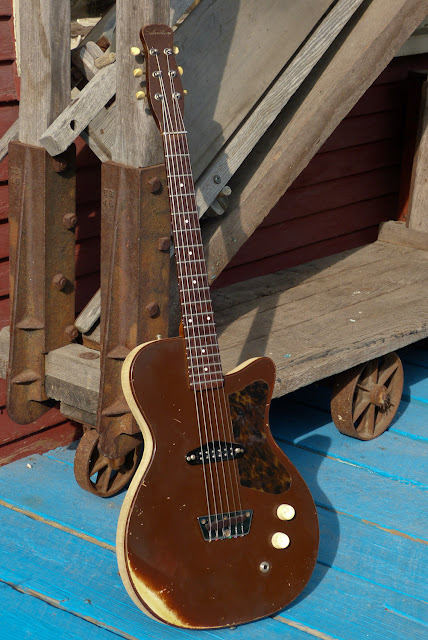1961 Danelectro-made Silvertone 1304 Semi-Hollow Electric Guitar
I adore New Jersey-made Danelectros. I simply do! They hold-up like solidbody guitars (yet are mostly semi-hollow) and are a testament to economy of means. This one is branded under the Silvertone (Sears) name and is, essentially, a short scale (23") U-1 model with a mid-placement pickup location. They call this the "1304" in Sears parlance. This one was made right at the tail-end of this model's production ('61) and it still has the "Coke-bottle" Dano-style headstock shape which gives it that '50s old-school look.
This particular guitar came in trade-wise from a friend of mine -- and I'm dolling-up a Strat for him with the original lipstick neck pickup of this guitar plus other odd-assortment pickups. Who knows, though -- maybe he'll see this and get jealous! It is short-scale, however, which gives it a certain tone and feel that may not suit all ears (or hands).
That being said, this came all-original but minus the pickguard, control cavity backplate, and (after yanking it out), the pickup. I gave the neck a fret level/dress and installed side dots, moved the neck-side strap button to the shoulder, replaced the wiring harness, routed and installed a Seymour Duncan Lil '59, reprofiled the rosewood bridge saddle for better compensation, replaced the missing pickguard and control cover with acoustic-style stick-on material, and then set it up with 56w-13 flatwound strings.
This last bit (heavier strings) is because I tend to only like electric guitars with this short a scale as "jazzbox/bluesbox" instruments -- check out this '56 Musicmaster with heavy gauges to see what it can do, too. Shorter scale means fewer overtones and harmonics, way-low string tension, and I always think they're sort-of mismatched with bright pickups. They make excellent rhythm guitars, though, in a chunky sort of way that suits the SD Lil '59 tone to a T.
That being said, this came all-original but minus the pickguard, control cavity backplate, and (after yanking it out), the pickup. I gave the neck a fret level/dress and installed side dots, moved the neck-side strap button to the shoulder, replaced the wiring harness, routed and installed a Seymour Duncan Lil '59, reprofiled the rosewood bridge saddle for better compensation, replaced the missing pickguard and control cover with acoustic-style stick-on material, and then set it up with 56w-13 flatwound strings.
This last bit (heavier strings) is because I tend to only like electric guitars with this short a scale as "jazzbox/bluesbox" instruments -- check out this '56 Musicmaster with heavy gauges to see what it can do, too. Shorter scale means fewer overtones and harmonics, way-low string tension, and I always think they're sort-of mismatched with bright pickups. They make excellent rhythm guitars, though, in a chunky sort of way that suits the SD Lil '59 tone to a T.
This thing shows plenty of wear but it's still kicking. As-normal for most Danos, it has a semi-hollow build with sides and center-block made from poplar and pine and a top and back of masonite. It was originally finished in brown sparkle but said sparkle is only found in unworn spots, now.
The original 1 5/8" aluminum nut is still going strong and the (sometimes fussy) tuners are actually doing quite well with the extra heft of the thick strings keeping them in check.
Most Danos feature rosewood boards with just the hint of a radius to them -- and in the case of this guitar, the neck profile is my favorite sort -- a thin, fast, C/D shape. Note added side dots.
I tried to use older hardware to match the aesthetic. I "pre-aged" the new pickguard a little, so when it reflects in the light it's not glassy and too "new."
I filled worn slots on the rosewood saddle and then compensated it properly for the wound-G stringing. The bridge plate sags (as usual) but the radius matches the fretboard perfectly with 1/16" action overall at the 12th fret.
I love that arm-wear!
Usually there's a sunken, bolt-on disc that fits in the control cavity area. It was missing, so I fashioned my own maple support (the light bit in the middle) and then cut a circle of the same pickguard material to cover it. This gives it a look reminiscent of some same-period Kay products.
The original hard case came with it, too!





















Comments
I totally get where you're coming from, though.